A few months ago, I was lucky enough to find myself in London and at the Tate Modern for an exhibition I was eager to see on one of my favorite subjects "Global Cities." The exhibition was a derivation from the 10th International Architecture Exhibition at La Biennale di Venezia in 2006 on the earth's urban crisis. As urban and population growth continues at exponential rates, and with the majority of the earth's population now residing in cities, the pressures on the environment, on society, on architecture, on open spaces and on the economy become even more complex and extreme. Unaddressed, this situation will only continue to become more tenuous and dire. Obviously the purpose of this exhibition was to raise awareness and to demonstrate some of the small changes that were already being made around the world to address these issues. And I think it was done rather effectively.
The spatial and social condition of 10 global cities - Cairo, Istanbul, Johannesburg, London, Los Angeles, Mexico City, Mumbai, Sao Paulo, Shanghai and Tokyo were presented. The analysis on these various cities were then divided into five themes - size, speed, form, density and diversity.
I have included below some of the questions that were raised on the huge billboards throughout the exhibition and some of the statistics about the various cities that were surprising if not shocking to me.
- Tokyo is the largest city in the world and the only mega-city (a city with more than 10 million people) that is a developed economy. (There is currently over 20 mega-cities around the world).
- Over 40% of Tokyo is already built on landfill
- In Tokyo 78% of its population travel to work by public transportation (in comparison to Los Angeles - where only 7% take public transport).
- Less than 5% of Tokyo's total surface is green space.

- Mexico City has expanded 10 fold in population and space since 1940.
- Over 60% of its population are in the informal economy.
- Cairo's population grew by 890% this past century.
- 60% of the city's residents live in unlicensed housing, some up to 14 stories high but with modern facilities.
- Cairo has 36,500 people per sq. km. (London has 4,500 per sq. km)
- Since open space is incredible scarce, Cairenes have co-opted unexpected parts of the city for use as social public space - including a multi-lane bridge over the Nile for evening picnics.

- Istanbul grew by 900% in the past 50 years; 27% in the past decade
- London's organic urban form extends for 60km along the River Thames covering an area of 1,572 sq. km. While this is double the size of New York City, it has the same number of inhabitants (7.5 million). Compared to other global cities, large amounts of London's surface is taken up with domestic gardens.

- Mumbai is India's most populous city with 18 million people. The population has increased by more than 1000% since the last century. It is set to grow by another 20% in the next decade.
- Rapid urbanization has produced poverty, poor health and employment instability. Lack of investment in transportation, sanitation and housing means that Mumbai is rapidly approaching breaking point.
- 90% of Mumbai's city population works informally.
- Mumbai will overtake Tokyo as the world's largest city in 2050 with nearly 40 million inhabitants.

- 20% of Shanghai's population are undocumented rural in-migrants who lack access to basic services. This floating population of 4 million is equivalent to almost half of the population of London.
- According to the UN, Shanghia is the 8th fastest growing city in the world - adding 29.4 new residents every hour.

- Los Angeles is a minority majority metropolis. Half its residents are Latinos, over 10% are of Asian decent. Only 30% of the population identify themselves as Anglophile white.
- 40% of LA's population were born outside the U.S.; 4 times the national average.
- Despite the extreme wealth of many of its residents, 20% of LA residents live in poverty.
- Only 4% of the residents of Johannesburg live beyond 65 years of age.
- Sao Paulo is ethnically diverse and young: 66% of its population is under 20 years of age.
Also as part of the exhibition, they commissioned various architects to create pieces that explored specific issues such as sustainability, public space and social inclusion specifically in London. I am not quite sure I understood the significance of these sculptures below, but they make pretty pictures....



































No comments:
Post a Comment